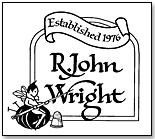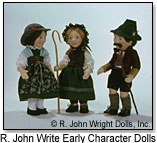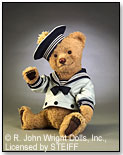|
|
The Art of Dollmaking R. John Wright Creates Collector's Editions
A dollmaker since 1976, when he was laid off from his job at a Brattleboro, Vt., hardware store, R. John Wright now enjoys international success. His award-winning company designs licensed character dolls and storybook figures along with its own creations. These editions are sold in toy and specialty gift shops. Wright and his wife Susan have come a long way since setting up their first booth at a craft show in Frederick, Md. They reached their goal of obtaining $5000 in wholesale orders, enabling Susan to quit her restaurant job and make dolls alongside her husband. Soon they had part-time workers helping and, within a year, full-time employees joined them at their ground-floor apartment, turning their home into a doll factory. They remained optimistic even when the situation didn't fully warrant it. "The most basic step we took from the beginning was to refuse to have anyone else produce our dolls or to sell our design or name to any other company," Wright explained. From 1976 to 1980 the company made ethnic Character Dolls. This was their research and development period, in which molded faces replaced sewn faces. Their primary inspiration was antique dolls. "Since we had no prior training or experience making dolls, every discipline had to be learned — from wig making to shoe making," Wright said. "As a result, the dolls changed rapidly during this relatively brief time, and they became increasingly sophisticated." After the release of their Little Children series in 1980, the company took off. By 1983 the business moved out of their home and into a manufacturing facility in Cambridge, N.Y. The couple does all the design work and production of the prototypes, while Susan trains a staff of 45. Their first license was with the Walt Disney Company, a 13-year relationship that helped them obtain other licenses. "We have built a strong reputation interpreting licensed characters faithfully to the point where our version is oftentimes referred to as the 'definitive' version. This impression has helped smooth the way for us to gain permission to produce some of our favorite characters." They choose projects that are "classic" or timeless, as opposed to untested properties. Wright said it would be fair to characterize their work as "elite," but these editions appeal to children as well as adults, even though it will be the adult making the purchase in an upper-end collector store or doll shop. They don't strategize about their target market. R. John Wright Dolls and Steiff will collaborate in 2006 on making the Steiff Kinderseries. They've recreated the faces of four dolls to resemble Steiff designs from 1911. This historic company is one of Wright's earliest inspirations. "We have always felt that the Steiff children dolls of the early 1900s were the perfect representation of childhood in the form of a simple, cuddly cloth doll," Wright said. "With their shoe-button eyes and unruly mohair wigs, they seemed like the human embodiment of a teddy bear — warm and tactile." Whether capturing a loved face of the past or the renowned image of a cartoon character, R. John Wright Dolls is now an asset to the doll industry. What follows is more information on several of the RJW designs.
Writer's Bio: Julia Ann Charpentier is a Milwaukee-based freelance writer and an editor for book publishers. Read more articles by this author
|
| |||||||||||||||||||||||||||||||||||||||||||||||||||||
Disclaimer Privacy Policy Career Opportunities
Use of this site constitutes acceptance of our Terms of Use.
© Copyright 2025 PlayZak®, a division of ToyDirectory.com®, Inc.










